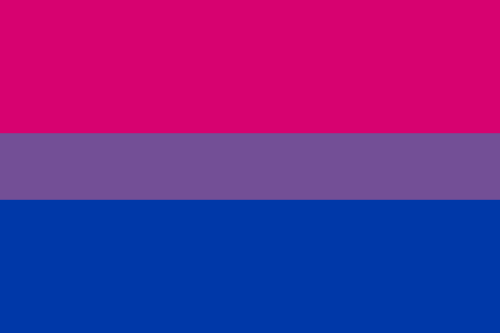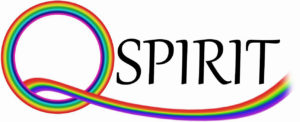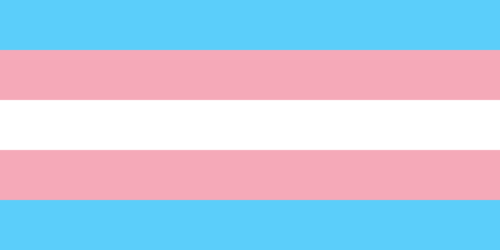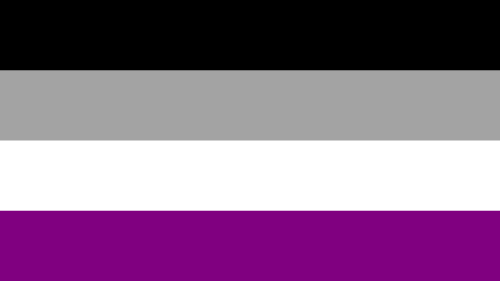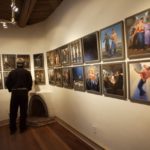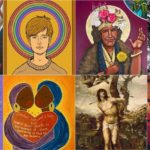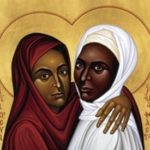Last Updated on April 27, 2025 by Kittredge Cherry
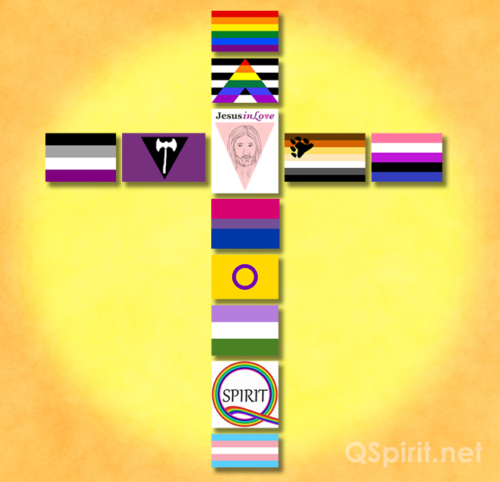
Discover the history and artistry of the LGBTQ community through the symbolism and stories behind its many flags.
Read between the lines of the rainbow flag to learn the origins of all the LGBTQ flags in the descriptions below. The rainbow flag came first, back in 1978. Since then dozens of new flags have been created, and more continue to be introduced as identities evolve and new communities emerge.
Can you name all the LGBTQ+ flags in this colorful cross? The flags are arranged as a cross to show that the body of Christ can include the LGBTQIAA+ community: people who are lesbian, gay, bisexual, transgender, queer, intersex, asexual, allies and all. Logos for Q Spirit and Jesus in Love emphasize the point. The LGBTQ community actually has even more flags, too many to fit here.
The vibrant multicolored cross was created for Q Spirit / Jesus in Love by its founder, lesbian Christian author Kittredge Cherry, with Andrew Murphy-Williams, a queer artist, writer and music maker based in Wales.
All the flags are labeled on the image below, followed by summaries with the meaning and background of each flag. Top to bottom: genderqueer, ally, Jesusinlove.org, bisexual, intersex, rainbow (LGBTQ or gay), Qspirit.net, transgender. Left to right: asexual, lesbian, Jesusinlove.org, bear brotherhood, genderfluid.
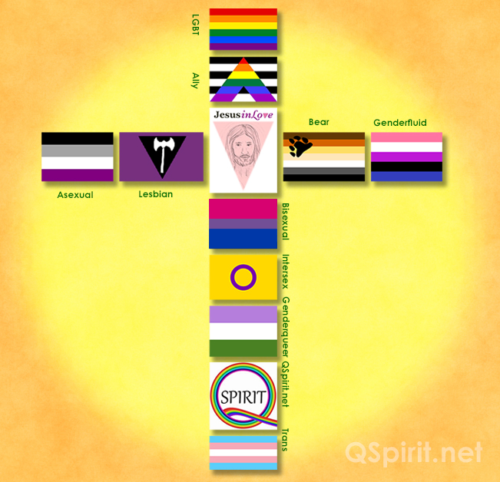
Rainbow flag (gay flag or LGBTQ flag)
 The rainbow flag celebrates the diversity and values of the LGBTQ community. It was designed by gay activist Gilbert Baker and debuted at San Francisco’s Gay Freedom Day Parade in on June 25, 1978. Over the years it went through several design changes as its popularity spread. Today the rainbow flag has six stripes, but the original had eight stripes with meanings assigned by Baker: hot pink (sex), red (life), orange (healing), yellow (sunlight), green (nature) turquoise (art), indigo (harmony) and violet (spirit).
The rainbow flag celebrates the diversity and values of the LGBTQ community. It was designed by gay activist Gilbert Baker and debuted at San Francisco’s Gay Freedom Day Parade in on June 25, 1978. Over the years it went through several design changes as its popularity spread. Today the rainbow flag has six stripes, but the original had eight stripes with meanings assigned by Baker: hot pink (sex), red (life), orange (healing), yellow (sunlight), green (nature) turquoise (art), indigo (harmony) and violet (spirit).
Baker created the flag at the urging of gay political pioneer Harvey Milk. As the developed the flag, Baker drew inspiration from the song “Over the Rainbow” by gay icon Judy Garland and the Flag of the Human Race, which represents all humanity with five horizontal stripes of red, white, brown, yellow, and black. Now the rainbow flag is recognized worldwide as a symbol of the LGBTQ community. Baker was widely mourned in the LGBTQ community when he died on March 31, 2017.
Controversy erupted in June 2017 when the rainbow flag was redesigned by queer black activist Amber Hikes. She added brown and black stripes to highlight LGBTQ people of color.
Ally flag
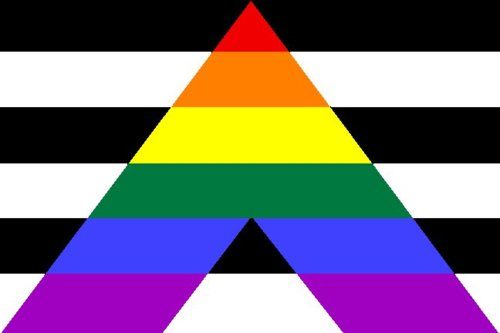
Straight allies of LGBTQ people have their own flag with a rainbow “A” for ally or activist. It is set against a background of black and white stripes that stand for cisgender heterosexuality. The flag emerged on the Internet around 2010.
Jesusinlove.org logo

The Jesusinlove.org logo shows the face of Christ in a pink triangle, the symbol imposed on gay prisoners in Nazi concentration camps. Inside the pink triangle, Jesus joins LGBTQ people in transforming suffering into power. Jesus in Love promotes artistic and religious freedom and teaches love for all people, regardless of sexual orientation, gender identity or religious faith. It is a project of lesbian Christian author Kittredge Cherry, who designed the logo herself in 2005.
Bisexual flag
Red overlaps with blue to create a thin purple stripe in the middle of the bisexual flag. It was designed by Michael Page, inspired by his volunteer work with BiNet USA and unveiled in 1998. Red represents same-sex attraction while blue symbolizes opposite-sex attraction. The overlapping purple stands for bisexuality. The purple stripe purposely merges with the other colors just as bisexual people tend to blend unnoticed into the gay, lesbian and straight communities.
Intersex flag
The intersex flag expresses the pride of people born with anatomy that doesn’t fit the typical binaries of male and female bodies. The background is yellow, which is considered a “hermaphrodite color” because it is neither feminine pink nor masculine blue. The purple circle stands for wholeness. The flag was introduced in 2013 by Organization Intersex International Australia.
Genderqueer flag
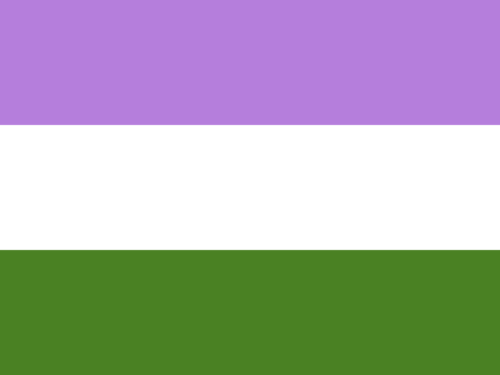
The genderqueer flag uses colored stripes to represent everyone who doesn’t fit either of the two traditional genders. The top stripe is lavender, mixing feminine pink and masculine blue to suggest androgyny. The middle stripe is white for neutral gender identity. On the bottom is dark green, the opposite of lavender, to symbolize non-binary identities such as third gender. It was created by genderqueer blogger Marilyn Roxie in 2010.
Qspirit.net logo
The logo for Qspirit.net shows the universal Spirit expressed in a unique way through queer experience. The rainbow colors of the contemporary LGBTQ flag create a colorful “Q” with a long tail that cradles and uplifts the Spirit. The Q can stand for queer, questioning one’s own sexuality or questioning spiritual and religious traditions. Basic black text conveys the fundamental, all-inclusive nature of the Spirit. The Q also shows commitment to quality — in writing, imagery and interaction with readers. Q Spirit promotes queer spirituality with LGBTQ saints, history, books and the Jesus in Love blog. The logo is designed in 2016 by Q Spirit founder Kittredge Cherry with queer Welsh artist Andrew Craig Murphy-Williams.
Transgender flag
The transgender flag was designed by trans woman Monica Helms, and was first shown in 2000 at a pride parade in Phoenix, Arizona. She explains, “The light blue is the traditional color for baby boys, pink is for girls, and the white in the middle is for those who are transitioning, those who feel they have a neutral gender or no gender, and those who are intersexed. The pattern is such that no matter which way you fly it, it will always be correct. This symbolizes us trying to find correctness in our own lives.”
Asexual flag
Asexual people honor their lack of sexual attraction with a flag where four stripes have symbolic meanings: Black (asexuality), grey (demisexuality or grey asexuality), white (sexuality), and purple (community). It was designed through a voting process by members of Asexual Visibility and Education Network in 2010.
Lesbian flag
Lesbian symbols combine with lavender on the lesbian flag. The black triangle was used by Nazis to designate prisoners with anti-social behavior, including lesbians. The labrys became a popular symbol in lesbian culture in the 1970s. It is a double-headed ax associated with goddesses and Amazon warriors. The lesbian flag was created by gay male artist Sean Campbell as a graphic image for the June 2000 Pride edition of Gay and Lesbian Times, but never gained wide popularity.
Bear brotherhood flag

A paw-print against brown stripes becomes the flag for the gay subculture affectionately known as “bears” — big, hairy masculine men. The flag was designed in 1995 by Craig Byrnes, a member of the bear community, and affirmed by a vote of the Chesapeake Bay Bears club. The seven stripes show the fur colors of various bear species.
Genderfluid flag
Five colors represent a mix of various genders in the flag for the genderfluid, orpeople whose gender identity changes over time: pink (feminine), white (no gender), purple (mix of feminine and masculine), black (all genders) and blue (masculine). The flag was created in 2012 by JJ Poole.
The LGBTQ community is spawning an almost endless variety of different flags. The LGBT Flag Gallery at Wikipedia displays 17 images, including national rainbow flags and such little-known flags as Twink Pride and Lipstick Lesbian. SavvyRed’s “Pride Flags Colors explained!” introduces more than 70 designs, apparently with a pride flag for every fetish and romantic attraction.
Religious tolerance is promoted by the rainbow Coexist flag, which features symbols of world religions and spiritual ideologies.
Thanks to friends who guessed the identity of the flags when the LGBTQ Flag Cross was first introduced here for Easter 2017 on the Jesus in Love Blog at Q Spirit.
Links related to LGBTQ flags
Rainbow Christ Prayer: LGBT flag reveals the queer Christ
Rainbow Christ Prayer translated into 10 languages
Someone Chained A Cross To Gay Street In NY. What Happened Next Was Beautiful (Huff Post)
“I First Saw The Rainbow Flag In A Church” by Kittredge Cherry (Believe Out Loud)
Welcome the New Year with rainbow candles! Bridge of Light honors LGBTQ culture
Copyright © Kittredge Cherry. All rights reserved.
Qspirit.net presents the Jesus in Love Blog on LGBTQ spirituality.
___
This post is part of the LGBTQ Calendar series by Kittredge Cherry. The series celebrates religious and spiritual holidays, events in LGBTQ history, holy days, feast days, festivals, anniversaries, liturgical seasons and other occasions of special interest to lesbian, gay, bisexual, transgender and queer people of faith and our allies.

